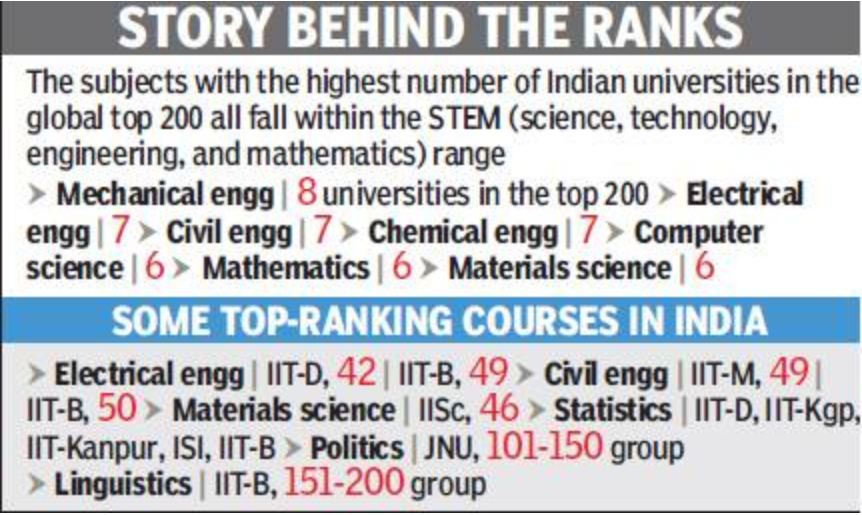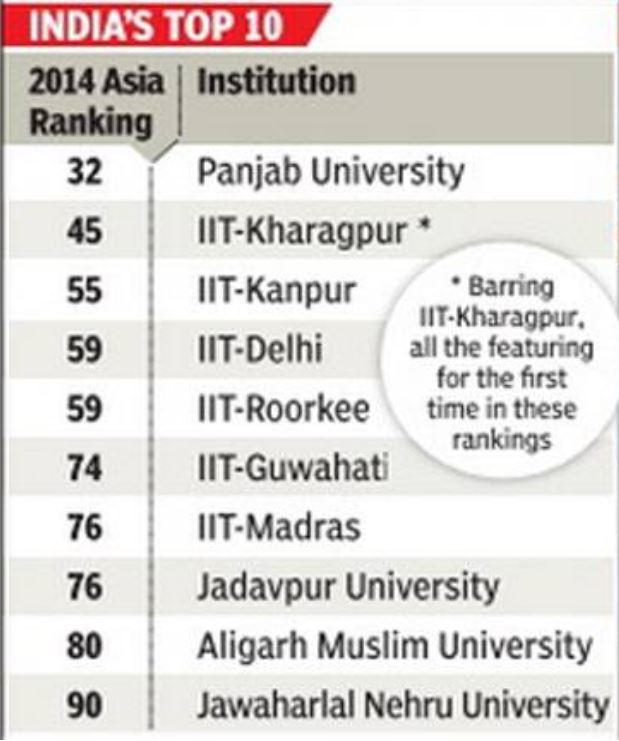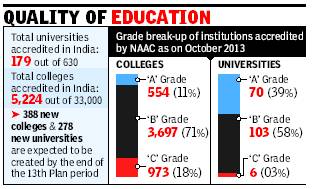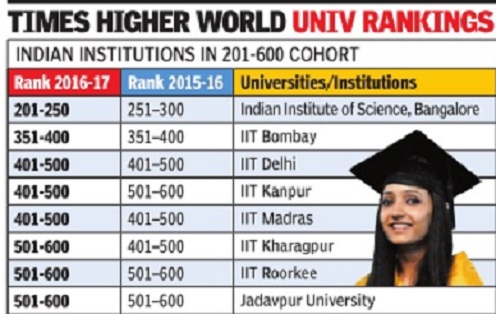Indian universities: global ranking
(→2020) |
(→2020) |
||
| Line 620: | Line 620: | ||
Union HRD minister Ramesh Pokhriyal said: “It is a significant achievement of our premier engineering institutions, which has made India proud.” IIT-D director V Ramgopal Rao said: “We are very happy to see a significant improvement in our rankings. This is a result of the various measures we have taken in the institute on boosting the research ecosystem, bettering teacher-student ratio and strengthening our connect with external stakeholders in the last three years. The number of international students has gone up to 130, most of them pursuing their masters and PhD.” | Union HRD minister Ramesh Pokhriyal said: “It is a significant achievement of our premier engineering institutions, which has made India proud.” IIT-D director V Ramgopal Rao said: “We are very happy to see a significant improvement in our rankings. This is a result of the various measures we have taken in the institute on boosting the research ecosystem, bettering teacher-student ratio and strengthening our connect with external stakeholders in the last three years. The number of international students has gone up to 130, most of them pursuing their masters and PhD.” | ||
| − | [ | + | ==Employability/ THE== |
| − | + | [https://epaper.timesgroup.com/Olive/ODN/TimesOfIndia/shared/ShowArticle.aspx?doc=TOIDEL%2F2020%2F11%2F19&entity=Ar00109&sk=40DD4414&mode=text Manash Gohain, November 19, 2020: ''The Times of India''] | |
| − | [[ | + | |
| − | + | [[File: Countries to which the most employable universities in the world belong, 2010-20.jpg|Countries to which the most employable universities in the world belong, 2010-20 <br/> From: [https://epaper.timesgroup.com/Olive/ODN/TimesOfIndia/shared/ShowArticle.aspx?doc=TOIDEL%2F2020%2F11%2F19&entity=Ar00109&sk=40DD4414&mode=text Manash Gohain, November 19, 2020: ''The Times of India''] | |
| − | [ | + | |frame|500px]] |
| − | + | ||
| + | India features among top 15 countries with universities producing the most employable graduates. In the Employability Rankings 2020, India has improved its ranking from 23 in 2010 to 15 in 2020, even as UK and US varsities showed declined. | ||
| + | |||
| + | The study by Times Higher Education (THE) and French consultancy, Emerging, for most employable locations for higher education, shows how top institutions in the US and the UK have masked the general decline of American and British universities in terms of employability. Countries, which have been taking employability more seriously over the past 10 years, are becoming more attractive than the US and the UK for students. | ||
| + | |||
| + | |||
| + | ''' IIT-D climbs to 27th spot on list of top 250 global univs ''' | ||
| + | |||
| + | India (15th) has been one of the high performers for employability over the last decade along with Germany (ranked 3rd), China (5th) and South Korea (9th). India also increased its representation in the top 250 universities worldwide — from four in 2019 to six in 2020. A notable performer is IIT-Delhi, which ranked 149th in 2014 and moved up to 27th in 2020. | ||
| + | |||
| + | As the Covid-19 situation has made finding work difficult for graduates, the study says students and parents are even more driven by the ability to get job rather than the reputation of a university. Although California Institute of Technology (1st), MIT (2nd) and Harvard (3rd) continue to dominate, there has been a general decline in higher education in the US. Its country score fell by 51% in the last 10 years — from 4,227 in 2010 to 2,067 in 2020. | ||
| + | |||
| + | The UK, too, where a small group of elite institutions are covering the general decline of its higher education system, fell from 2nd position in 2010 to 4th in 2020 in terms of best performing countries for employability. Its country score dropped by 46% in 10 years (1299 in 2010 to 697 in 2020). China’s country score saw an increase of 132% over the past 10 years (208 in 2010 to 481 in 2020). | ||
| − | [[Category:Education|UINDIAN UNIVERSITIES: GLOBAL RANKING | + | [[Category:Education|UINDIAN UNIVERSITIES: GLOBAL RANKINGINDIAN UNIVERSITIES: GLOBAL RANKING |
INDIAN UNIVERSITIES: GLOBAL RANKING]] | INDIAN UNIVERSITIES: GLOBAL RANKING]] | ||
| − | [[Category:India|UINDIAN UNIVERSITIES: GLOBAL RANKING | + | [[Category:India|UINDIAN UNIVERSITIES: GLOBAL RANKINGINDIAN UNIVERSITIES: GLOBAL RANKING |
INDIAN UNIVERSITIES: GLOBAL RANKING]] | INDIAN UNIVERSITIES: GLOBAL RANKING]] | ||
| − | [[Category:Pakistan|UINDIAN UNIVERSITIES: GLOBAL RANKING | + | [[Category:Pakistan|UINDIAN UNIVERSITIES: GLOBAL RANKINGINDIAN UNIVERSITIES: GLOBAL RANKING |
INDIAN UNIVERSITIES: GLOBAL RANKING]] | INDIAN UNIVERSITIES: GLOBAL RANKING]] | ||
Revision as of 13:45, 22 November 2020
See the page South Asian universities: global ranking for complete lists, not only of South Asian universities, but of Indian universities as well, taken from original sources.
This is a collection of articles archived for the excellence of their content. Readers will be able to edit existing articles and post new articles directly |
2012: IITs put India on world map
The IITs in global rankings
IITs put India on world map / 3 Institutes Feature In Top 50 Global Univs For Engg Courses
Kounteya Sinha , The Times of India 2013/05/09
London: IIT Delhi’s electrical engineering department has been ranked the 37th best globally, the highest entry from India across all categories in the latest Quacquarelli Symonds (QS) world university rankings.
QS is a reputed British education and career advice company, which, until 2010, produced the rankings with the Times Higher Education.
The IIT Bombay’s civil engineering department has been ranked 39th while IIT Delhi’s mechanical and aeronautical engineering department has been positioned 43rd. Indian Institute of Science ranks 50th in materials science.
IITs have come as the only saving grace for Indian universities in the rankings released on Wednesday. Not a single university or department has made it to the top 200 altogether in 12 of the 30 disciplines covered in the global rankings.
Important subjects without a single Indian institution featuring in the top 200 include medicine, law, economics and education.
The best performances from Indian universities came in the field of engineering, as expected. IIT Bombay, IIT Delhi and IIT Madras are all ranked in the global top 50 in at least one of the four areas of engineering: civil, mechanical, electrical and chemical.
2012: Global ranks of leading Indian universities
Delhi University and JNU have made it to the top 100 in the world for English literature. Chinese universities, on the other hand, have bagged 37 top-50 rankings in 23 subjects, compared to just four for India.
“These rankings reflect the progress made by the IITs in recent years in engineering, but in many other areas of the academic spectrum, India is lagging way behind its international competitors,” said QS head of research Ben Sowter.
“India faces numerous challenges as it attempts to expand participation and increase university funding. These rankings make it clear that it is some way off achieving a truly internationally competitive higher education system,” he added.
Covering 30 subjects, the QS rankings by subject are the largest of their kind. The US and UK universities dominate the list, with Harvard ranking number one in 10 subjects, ahead of MIT (7), University of Oxford (4), UC Berkeley (4), University of Cambridge (3), Imperial College London (1) and UC Davis (1).
IIT Delhi’s electrical engineering department has been ranked the 37th best globally, the highest entry from India across all categories in the latest QS world university rankings
2013: a slide
IITs see steady slide in world rankings
Hemali Chhapia, TNN | Sep 12, 2013
IITs see steady slide in world rankings
In 2013, five IITs remained the country’s only representatives in the top 400 list. In the Asian rankings, most institutes slid in their positions compared to 2012.
MUMBAI: Lakhs of teenagers may be aspiring to join the Indian Institutes of Technology, but over time, as their international peers have been inching upwards, these elite national colleges have been taking a beating in the global rankings. Between 2009 and 2013, the IITs saw a steady slide in the Quacquarelli Symonds (QS) rankings.
This year, five IITs remained the country's only representatives in the top 400 list. In the Asian rankings, most institutes slid in their positions compared to 2012.
The analysis by QS states: "The five leading Indian institutions all rank lower than last year, and there has been a general lack of progress since the rankings began in 2009—surprising, since for much of that period the Indian economy was expanding at a rate of up to 9% per year."
In 2009, IIT-Bombay led the pack at 163. In 2009-13 it fell several spots. Experts said the IITs had increased research publication, though comparatively low citation rates suggested they were yet to achieve widespread impact within academic community.
In Asia, IIT-Delhi was at 38 (36 last year) and IIT-Bombay at 39 (34).
2013: Global ranks of leading Indian universities
The University of Delhi was at 80 (78), the University of Mumbai improved its ranking to 140 (151-160) and the University of Calcutta retained its position at 143.
2014
2014: QS World University Rankings by Subject
Courses from 3 IITs, IISc are in global top 50
Hemali Chhapia,TNN | Feb 26, 2014
MUMBAI: Four Indian universities, including the IITs at Delhi and Mumbai, are among the global top 50 in at least one of the 30 disciplines covered under the QS World University Rankings by Subject.
IIT-Delhi achieved the country's highest position, ranking 42nd in electrical engineering. IIT-Bombay was 49th in electrical engineering and 50th in civil engineering, IIT-Madras 49th in civil engineering and the Indian Institute of Science 46th in materials science.
No course from Indian universities figure in areas such as arts, humanities and social sciences. IIT-Bombay is the only one in the top 200 in any of the five arts and humanities disciplines, ranking in the 151-200 grouping for linguistics.
The five life sciences disciplines feature only two Indian institutions, while India draws a blank in six of the eight social sciences disciplines. The exceptions are statistics, in which five Indian institutions— IIT-D, IIT-Kharagpur, IIT-Kanpur, Indian Statistical Institute and IIT-B — feature, and politics, in which Jawaharlal Nehru University appears in the 101-150 grouping.
All round, IIT-B emerges as the top institution with four of its courses making it to the rankings.
"The IITs continue to perform well in their specialist areas and the inclusion of three of them in the global top 50 in the engineering disciplines shows that they are starting to achieve genuine international renown," said QS head of research Ben Sowter.
On the other hand, the lack of world-renowned Indian programmes in arts, humanities and social sciences continues to be a concern, Sowter said. "The absence of Indian universities from the top 200 in subjects such as medicine, law, economics, accounting and finance underlines the difficulty India faces in reversing the tide of talented students leaving the country to study these disciplines abroad," he added.
"The latest QS rankings highlight the excellence of the specialist Indian institutions in the STEM (science, technology, engineering, and mathematics) area and also identifies the need to improve the global competitiveness of our universities, in particular the large and comprehensive institutions," said Mohandas Pai, chairman, ICAA — Indian Centre for Assessment & Accreditation.
The encouraging performance of the IITs in engineering and technology fits into a pattern of strong performances by Asian institutions in the STEM disciplines. Asia accounts for 10 of the top 30 institutes in chemical, civil and electrical engineering, and eight in mechanical engineering, showing that several institutions in the region can now be considered serious global players.
National University of Singapore makes the global top 10 in all five engineering and technology disciplines, while Hong Kong accounts for three of the top 20 institutions for computer science: the Hong Kong University of Science & Technology (11th), the University of Hong Kong (14th), and Chinese University of Hong Kong (18th).
"The STEM disciplines have been the primary focus of global competition over the past decade as institutions in countries such as Singapore, Hong Kong, China and Korea have emerged as genuine competitors to the traditional research powerhouses in the US and UK," said Sowter.
2014: Times Higher Education World Reputation Rankings
No Indian university in top 100 global list, Harvard voted best
M Ramya,TNN | Mar 7, 2014
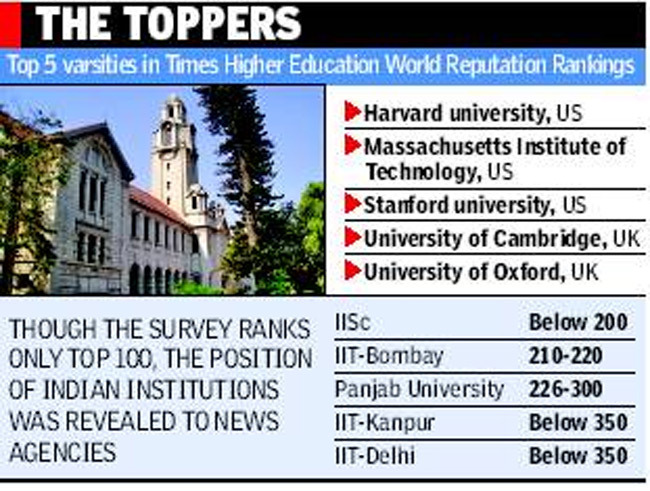
From: The Times of India, March 7, 2014
CHENNAI: None of India's 700 universities and 35,539 colleges has made it to the top 100 list of the Times Higher Education World Reputation Rankings released.
The ranking, drawn on the findings of an invitation-only academic opinion survey, is based on the subjective judgment of around 60,000 senior, published academics considered as "the people best placed to know the most about excellence in our universities".
Agency reports said that Punjab University, the alma mater of Prime Minister Manmohan Singh, found a place in the unranked section of 226 - 300. [Indpaedia’s note of caution: could Punjab University, Lahore?] It is followed by the IITs in Delhi, Kanpur, Kharagpur and Roorkee between ranks 351 and 400.
Indian Institute of Science, Bangalore is ranked highest among Indian institutions, at just below 200, from its 130th place last year. IIT-Bombay figures among the 210-220 group, and IIT-Delhi and IIT-Kanpur are ranked below 250.
The US has the most representation with more than 45 institutions figuring in the top 100 followed by the UK with 10 institutions, Germany with six and Japan and Australia with five. India is the only BRIC country that is not represented in the top 100 list. China has two of its institutions on the list while Brazil and Russia have one each.
According to data put together by the Institute of International Education on international student mobility in 2012, the number of foreign students registered in Indian higher education institutions in 2012 is 27,000, much lower than in other Asian countries like China (3.28 lakh) or Japan (1.37 lakh).
2014: IIT Guwahati at no. 87 among universities under 50 years of age
IIT Guwahati leads India into top 100 global varsity rankings PTI | May 1, 2014
LONDON: The prestigious Indian Institute of Technology-Guwahati has made it to the world's top 100 university rankings, bringing India for the first time on the list.
IIT-Guwahati is the only Indian educational institute in the 2014 league table of '100 Under 50' institutions [i.e. founded after 1964] released by the 'Times Higher Education' (THE) magazine here yesterday.
The IIT shares the 87th rank on the list with Portugal's New University of Lisbon and Australia's University of Western Sydney.
The annual evaluation of the world's top 100 universities under 50 years of age had a distinct Eastern stance with South Korea's Pohang University of Science and Technology topping the list for the third consecutive year.
"There has been a great deal of soul-searching in India over the fact that none of its universities make the World University Rankings' top 200 - a serious concern given the country's great intellectual history and growing social and economic influence," said Phil Baty, rankings editor at THE magazine.
"But this new analysis, which examines the next generation of global university stars, should be encouraging. Of the 'BRICS' nations, Russia, mainland China and South Africa do not make the grade, so it is cause for optimism that the Indian Institute of Technology Guwahati breaks into the top 100," he added.
The '100 Under 50 2014' uses the same comprehensive list of 13 performance indicators that underpin the prestigious THE World University Rankings, but employs an especially re-calibrated methodology to better capture the characteristics of young institutions.
2014: Times Higher Education Asia Rankings
Panjab University pips IITs in new ranking
The Times of India Manash Pratim Gohain, TNN | Jun 20, 2014
Panjab University, Chandigarh upstages Indian Institute of Technology, Kharagpur as India's number one university and is placed at 32nd position among Top 100 Asian universities. Overall, it has been a significant stride by Indian universities as 10 of them now features in "Times Higher Education (THE) Asia University Rankings 2014," three more than last year. In fact Indian is the most improved nation in this year's rankings by far. The 2014 rankings also feature six IITs in top 100. However, there are no Indian institutions yet to make it to the Top 10 in the Asian rankings.
According to Phil Baty, editor, THE rankings, there were 20 Indian participants of which 10 made it to the top 100, "which is a good show," and "in the next rankings we are coming up in October 2014 we are expecting around 30 to 40 participants from India."
Barring IIT-Kharagpur, none of the Indian universities in Top 100 were ranked in 2013 rankings. IITs still continues to be the big representatives of India in international rankings with the youngest IIT from Guwahati too making its appearance at 74th position. Not technical institutions — Jadavpur University, Aligarh Muslim University and Jawaharlal Nehru University - are also in Top 100 Asian universities.
Commenting on India's performance Baty said: "We are not rewarding volume and size. We are rewarding quality. India is fifth best representing country in this ranking. And majority of these are new entrants. But India is massively under served by quality universities."
Panjab University, Chandigarh
Panjab University is one of the oldest Indian university established in 1882 at Lahore (now in Pakistan). In 1956 the university was relocated to Chandigarh, on a red sandstone campus designed by Swiss architect Pierre Jeanneret under the guidance of the legendary Le Corbusier.
Professor A K Grover, vice-chancellor, PU, said: "PU traditionally has been a very good university. In fact what DU is trying to do now we did it in Lahore in 1920, that is the four-year-undergraduate-programme. About the rankings, there are roughly 10 universities within the same bracket. The only advantage is PU is so integrated and has the benefit of the architecture to present and earn a few points extra. The campus is so structured that a walk from any hostel to any department won't take more then seven minutes and it promotes interdisciplinary. Therefore it is easy to attract good students. We too have lot of politics in the campus, but majority of the scholars are serious academics."
All the Indian universities which made it to the Top 100 are public funded universities, though there were private universities among the 20 which participated in the assessment process. While the global leaders are private universities, the Indian private institutions "could not make it to top 100 due to lack of infrastructure and research," said Baty.
Japan is the number one nation with 20 representatives in the Top 100 and its University of Tokyo at the top, followed by Singapore's National University of Singapore. But China too is not far behind with 18 of its universities in the Top 100.
2014: National Assessment and Accreditation Council’s (NAAC) assessment
Indian univs second-grade?
89% Of NAAC-Accredited Institutes Are ‘Average’ Or Worse
Manash Pratim Gohain TNN
New Delhi: If rankings and grading are any indicator of quality, Indian institutes of higher learning have a long way to go — both locally and globally. An astonishing 89% of India’s accredited colleges and universities are graded either ‘average’ or ‘below average’, raising serious doubts about their quality.
While globally India’s [South Asia’s?] top rated institute — Panjab University — ranks between 226 and 250, the National Assessment and Accreditation Council’s (NAAC) assessment is no better, with 62% of universities accredited rated average or below average. Moreover, the actual picture on the ground is likely to be even worse since only 179 varsities and 5,224 colleges have valid accreditation out of a total of 630 varsities and 33,000 colleges. [Indpaedia’s note of caution: could Punjab University, Lahore?]
NAAC director A N Rai said, “Only 11% of our accredited institutions are ‘A’ grade, while 71% are ‘B’ grade. The remaining 18% are in the lowest ‘C’ grade. This definitely shows the quality of the institutions. But we have to consider various parameters. As most institutions are government-run, there is a serious financial and infrastructure crunch which adversely affects the assessment. But we have to appreciate the fact that despite being voluntary they came for the assessment.”
From 2014, however, accreditation has been made mandatory and linked to funding under Rashtriya Uchchatar Shiksha Abhiyan.
2015
2015: Ranking by US News
See graphic 'Best Global Universities: 2015'
2015: Tiles Higher Education
There was no Indian university ion the Top 100.
2015: QS World University Rankings by Subject
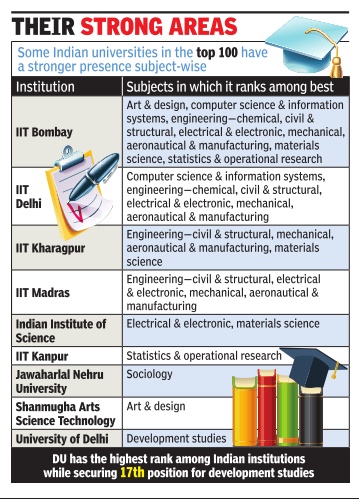
The Times of India, Apr 30 2015
Manash Gohain
DU, JNU, IIT depts make it to global top 100 list
Nine Indian varsities in QS rankings within nine disciplines
Indian universities might struggle to make the top 100 of the QS World University Rankings list, but their individual departments are amongst the best in the world. Delhi University tops the list, achieving the highest rank of all 20 Indian universities that have made the cut, while being placed 17th globally on the development studies subject table. Nine Indian institutions are listed in the top 100 within nine disciplines. In the QS World University Rankings by Subject 2015 published, India has secured 107 places across the 36 subject tables, including the six new disciplines for 2015--architecture, arts and design, business studies, dentistry , development studies and veterinary science.
IIT Bombay is the most prevalent Indian institute, appearing in the top 100 for eight subjects. IIT Delhi too has five of its departments in the top 100 while Jawaharlal Nehru University figures on one subject list. “This is a reflection of the progress made by Delhi University in four years.Rankings have improved in several disciplines. If we can keep up the momentum, we would be placed even higher next year,“ Malay Neerav, media coordinator, DU, said.
Within the inclusion of the new subject of art and design, Shanmugha Arts Science Technology and Research Academy , Thanjavur, has been placed in the top 100, while Indian Institute of Science, Bangalore, has made it for materials science and electrical and electronic engineering. From Delhi, IIT also appears in the top 100 for civil and structural engineering, electrical and electronic engineering, mechanical aeronautical and manufacturing engineering and computer science and information system.
However, in business and management studies, none of the B-schools could make it into the top 100. The top ranks in this subject table are shared by IIM Ahmedabad, IIM Bangalore and IIT Delhi.
2015: Number of women vice-chancellors
The Times of India, Jun 05 2015
Chethan Kumar
Only 13 of India's 431 universities have women VCs
The prestigious Oxford University announced that Professor Louise Richardson, subject to approval, could go on to become the university's first woman vice-chancellor in its 800-year-old history . Down in India, things are not too different. Multiple studies reveal the percentage of women vice-chancellors here is a shocking 3%, with just 13 universities of the 431, a UGC study surveyed, having women running a varsity . This, despite girls outdoing boys year after year in exams, and women constituting more than 50% of teaching posts in universities.
According to a British Council commissioned report titled `Women in Higher Education Leadership in South Asia: Rejection, Refusal, Reluctance, Revisioning', the percentage of women teaching staff drops drastically at higher levels. “Women constitute only 1.4% of the professoriate, though there are many at other positions like readers, lecturers etc,“ the report released in February 2015 notes.
Adding that even of the 13 women VCs, six are from allwomen universities, the report flags the culture of discrimination. “There are many reasons -from the way selection committees are constituted to the way women and men think. Most women academicians are more passionate about teaching than running institutions, which is why many of them, although qualified, do not choose to apply for such posts,“ Meena Rajiv Chandawarkar, VC , Karnataka State Women's University, told TOI.
Quoting a UGC-constituted task force in 2013, the report says, “Glass ceilings and fears over promotion must receive more attention, the feedback indicates widespread practices of discrimination and harassment among women working in higher education institutions.“
Berin Lucas, sociology professor of St Joseph's College of Arts and Science says, “Higher education must open its doors to new learning, but it is only a reflection of the patriarchal fabric of society , which operates in every spectrum of life, not even exempting education.“ The report, though, paints a bright picture at the under-graduate level for women.
2015: IIS, Bangalore; IIT, Delhi in Top 200
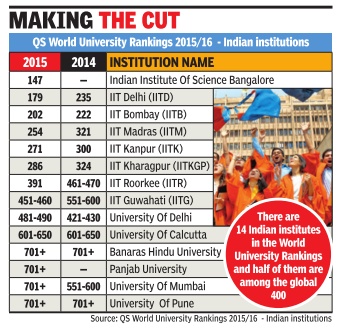
The Times of India, Sep 15 2015
Kounteya Sinha
In a 1st, 2 Indian institutes make it to world's top 200
Two Indian institutes have for the first time made it to the top 200 list of the world's best universities. The Indian Institute of Science, Bengaluru, has taken the top spot among its Indian counterparts, bagging the 147th rank. The only other Indian institute to make it to the top 200 is Indian Institute of Technology Delhi, ranked 179th this year. It has made great progress from last year when it was ranked 235th in the world.
According to the QS World University Rankings 2015, there are 14 Indian institutions in the World Uni versity Rankings and half of them are among the global 400. The bad news is that the University of Delhi and the University of Mumbai have lost ground.
The Massachusetts Institute of Technology (MIT) is the world's top university , closely followed by Harvard.The University of Cambridge is tied to Stanford Uni versity for the third place.London is the only city in the world with four universities in the top 50, more than Boston and New York (3) Paris, Sydney , Hong Kong and Beij ing (2), with the London School of Economics and Po litical Science making the top 40 for the first time.
In an exclusive interview to TOI, Ben Sowter, QS head of research, said, “India has two institutions in the top 200 this year, which has occurred as a result of QS evolving its methodology to be more even-handed across subject areas and it has revealed strength in research in engi neering, technology and the natural sciences. If you want to compare India and China, the primary shortfalls are money and consistent policy leadership.“
Thirty-four countries are represented in the top 200.
The US is the dominant nation, with 49 institutions, ahead of the UK (30), the Netherlands (12), Germany (11), Canada, Australia, and Japan (8), China (7), France, Sweden and Hong Kong (5).
2015: Times Asia rankings
The Times of India, Jun 11 2015
Manash Gohain
Only 9 Indian univs make it to Times Asia rankings 2015
China beats Japan, heads top-100 list
Indian Institute of Science, Bangalore upstaged Panjab University as India's number one university, while IISc and IIT,Bombay , were the two new entrants in the top 100 of the Times Higher Education University Asia Rankings 2015, released on Wednesday . However, there is cause for concern as this year only nine Indian universities made it to the top 100, down from 10, whereas IIT-Guwahati, IIT-Kanpur and Jadavpur University-which made it to the top 100 comfortably last year-have exited the rankings altogether this time. Meanwhile, China has overtaken Japan as the Asian power house in education, but Japan's University of Tokyo is still in the numero uno position.
IISc-Bangalore entered the table at 37th, one place ahead of last year's leader, Panjab University , whose rank fell from 32. Five IITs, led by IIT-Roorkee (joint 55th) formed the lion's share of the country's representation, although Aligarh Muslim University (90th) and Jawaharlal Nehru University (96th) too made it to the top 100.
Phil Baty , editor of The Times Higher Education Rankings, said, “It is cause for concern that India has lost ground in the league ta ble. Most of last year's representatives have fallen down the list. With India's major chunk of population under 25 years of age, it is more crucial than ever for India to invest in research and strengthen its academic links with other nations. “ The Asia rankings use 13 performance indicators to examine each university's strengths against its core missions of teaching, research, knowledge transfer and international outlook.Besides seeding its position to China, many of Japan's representatives have lost ground, with only 19 universities in the list, down from 20 last year and 22 in 2013.
China now has 21 representatives in the top 100, going past Japan for the first time, with three of its universities as new entrants. Last year China had 18 universities and 15 in 2013. Both Peking University (fourth) and Tsinghua University (fifth) have moved up a place.
Hong Kong University managed to retain its third place and had a strong presence from the Chinese special administrative region, with all six of its universities in the top 50. The Hong Kong University of Science and Technology rose from ninth to seventh, while the Chinese University of Hong Kong stood at 13th.
“The world expects Asia to be the next global higher education superpower after Europe and North America.Times Higher Education data shows many of the continent's leading universities competing on equal terms with the best in the West,“ said Baty .
2015: QS World Universities ranking
The Times of India, Sep 24 2015

QS WORLD UNIVERSITY RANKINGS 2015-16 - INDIAN UNIVERSITIES AMONG WORLD'S TOP 200
Since its launch in 2004, the QS World University Rankings remains a major news event around the world. And they matter enormously to academics, university managers, students, alumni and other key groups in higher education. As with any ranking, the big names near the top are the first to attract attention. We find that the Massachusetts Institute of Technology is still the world's top university. It has near-perfect scores on five of our six measures, but falters on our indicator for international students where it gains a mere 95.5 out of a possible 100. It is 62nd in the world on this measure. In second place is Harvard, which also performs extremely well in all the indicators, except for the proportion of international students. The top 20 we see here is dominated as usual by an array of household-name institutions in the US and the UK. US universities take 10 top-20 places and the UK five. Two of the others are in Switzerland, two in Singapore and one in Australia.
There is bound to be close attention to the effects of this year's major improvement to the rankings, the faculty-level normalisation of our citations count. The intention is to counteract the ferocious publish-or-perish culture of the biomedical field, and in the natural sciences, by equalising the effect of citations in the major areas of academic life.
For this year, its effects can be seen most starkly in the improved standing of institutions with a strong emphasis on the social sciences and the arts and humanities. Most striking is the rise of the London School of Economics from 71st place to 35th, driven by a rise in its citations ranking. In general, the effect of this change on large universities with a comprehensive range of subject provision ought to be broadly neutral.This applies to most of our topranked institutions, so there have been few if anyearthquakes in the upper reaches of these rankings.
However, universities with a strong emphasis on the biomedical sciences lose the advantage afforded by our previous methodological approach in counting citation per faculty.
The most visible example is Imperial College, London. It has fallen from the number two position to eighth. The main reason is indeed the fall in its citation per faculty member indicator, as a result of the normalization applied to this measure. This is the only one of our six measures on which Imperial does not have a near-perfect score.
The other startling result near the top of these rankings is the rise of Nanyang Technological University in Singapore. NTU is up 26 places to 13th, one place behind the National University of Singapore, making NTU much the newest top university in the world.In addition, it has proved possible for medicine-intensive universities to offset the effects of the citations changes by improving elsewhere. Examples include Johns Hopkins and Yale in the US. They both lost out in the citations reform, but have fallen less than might have been expected by doing better on other measures.
This new approach to citations allows us to look afresh at the relative standing of world higher education systems. One example is the possible rise in the standing of Asian higher education. Across the region, universities have been the focus of massive political emphasis, and of substantial financial investment. We have already seen that Singapore's commitment to learning and research is a success, with two top-20 universities in this ranking.
These rankings show little material change in the standing of universities in Japan, Korea or Taiwan. The main winners are in China and India. China's two top institutions, Tsinghua and Peking universities, are up by 22 and 16 places respectively to 25 and 41. In India, seven of the Indian Institutes of Technology are up this year including top-rated IIT Delhi (179th) which breaks into the Top 200 for the first time ever. As a general rule, engineering and technology attach less importance to citations than science and medicine. The top Indian institution is the Indian Institute of Science Bangalore. It is a new entry at a praiseworthy 147, having satisfied QS that its work is broadly-based enough to be included in our global ranking.
Ben Sowter, QS head of research says “India's universities have clear strengths in technology and natural sciences, and with the historic emphasis on medical research now neutralized, are reflected in their rightful place in this year's tables. On a cautionary note, however, it's important to highlight that the trend in a number of key measures remains downward, so to retain and improve upon this year's results, the Indian Higher Education establishment must not be complacent, and must continue to drive for greater international recognition.“
There are 14 Indian institutions in the QS World University Rankings and half of them are among the global 400. While the IITs and the Institute of Science have all progressed in this edition, the large comprehensive universities, such as the University of Delhi and the University of Mumbai have lost ground, principally because of the normalisation by faculty applied to the research indicator but also due to deterioration in other dimensions as well.
The University of Delhi features among the world's top 200 in the Social Sciences & Management (191th) and Arts & Humanities tables (176th) while Jawaharlal Nehru University is the leading Indian university in this area (168th). Unsurprisingly, Indian institutions excel in the Engineering & Technology area, with five IITs among the Top 100 in the world while they also have a fairly strong profile in the Natural Sciences.
2015: 17 Indian institutions in Times' top 800
The Times of India, Sep 30 2015
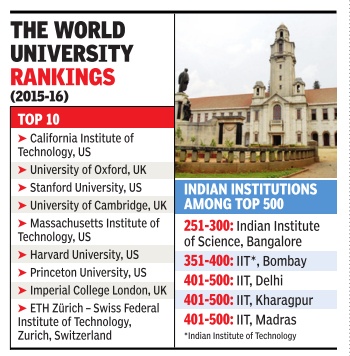
Manash Gohain
17 Indian institutions among Times' top 800
India put on a better show than previous editions at The Times Higher Education World University Rankings 2015-16, to be released on Wednesday , after the list was expanded to top 800 from 400. But none of them breached the top 200.
The highest ranked institution is the Indian Institute of Science, Bangalore, placed in 251-300 rank group and the other institution among the top 400 is Indian Institute of Technology , Bombay (351-400 cohort). In all, India has 17 universities in the list, matching its BRIC counterpart Brazil. Among Asian countries, China continues to dominate, while Japan and South Korea have fallen behind.
Phil Baty , editor of the Times Higher Education World University Rankings, said: “India will have to work harder to compete with other emerging economies such as China, which has 37 institutions, and Russia which has fewer institutions overall but a higher proportion in the upper echelons of the table.“
“With the population of young people in the country expanding, resulting in further pressure on resources, it is now more crucial than ever that India invests in research and strengthens its links with other nations. The Centre is yet to implement an initiative in this area,“ he said.
In Asia, the National University of Singapore holds the number one spot (in 26th place), while China's Peking and Tsinghua universities are at 42nd and joint 47th respectively .
2015: IISc first Indian university in world top 100
Sources:
1. The Times of India, Nov 13 2015
2. The Times of India, Nov 13 2015, Manash Gohain
IISc is first Indian univ in world top 100
Bengaluru's Indian Institute of Science (IISc) has broken into the list of top broken into the list of top 100 universities of the world -a first for an Indian university . The institute has ranked 99th in engineering and technology cat neering and technology category of the Times Higher Education list, reports Manash Pratim Gohain. The list is an annual publication by the UKbased Times Higher Education (THE) magazine. Asian universities made up more than a quarter of the top 100 list, claiming 26 spots, up from 18 in 2014.
“This year's stand-out success story has to be India, making its debut in this prestigious engineering and technology ranking, which represents the top few per cent of world universities for these subject disciplines, said THE World University Rankings editor Phil Baty . “Whether you look at hightech sectors such as IT or aerospace engineering or more traditional fields such as steelmaking, India's engineering and technology prowess is highly visible the world over in the shape of companies based in India or run by people born in India, such as Google and Microsoft, Infosys and Wipro or Tata and Mittal. Maximum weightage (30%) is given to teachinglearning environment and research followed by research, citations (27.5) and international outlook (7.5%). IISc scored 60.7 points for teaching and 46.7 in research as per performance breakdown of the ranking. In teaching, IISc is among the top 50 universities while for research it is ranked 77th.Six Asian universities make the top 30
2016
2016: Times Higher Education BRICS and Emerging Economies rankings
The Times of India, December 4, 2015

BRICS & EMERGING ECONOMIES - 16 desi institutes figure in Times' top 200 univs Indian educational institutes occupy 16 places among top 200 universities in Times Higher Education BRICS and Emerging Economies rankings for 2016.At 16th place, Indian Institute of Science, Bangalore is the only Indian institute to feature in the top 20. China, on the other hand, has five institutes among top 10, followed by two from South Africa, and one each from Taiwan, Brazil and Russia. Even Taiwan has done better than India with 24 universities in top 200.
Releasing the report on Thursday , Phil Baty, editor, Times Higher Education World University Rankings, said, “It is good news for India that 16 of its institutions feature in this year's list of the best universities in the BRICS nations and emerging economies. However, India will have to work harder to com pete with other developing nations, such as Russia, which have a higher proportion of institutions in the upper echelons of the table. India is the only BRICS nation without a university in the top ten.“
At 29th place, Indian Institute of Technology , Bombay makes to the Top 30, but rank ings show that it requires investment and international collaboration if it has to compete with institutions from other BRICS nations.
China dominates the rankings, with Peking Universityand Tsinghua University at first and second position respectively. The University of Science and Technology of China is at seventh place, Zhejiang University at eighth and Shanghai Jiao Tong University at tenth. Lemonosov Moscow State University from Russia is at third place; from South Africa, University of Cape Town from is at fourth and University of Witwatersrand is at sixth. National Taiwan University is at fifth. University of Sao Paulo, Brazil is at ninth place.
Baty said, “India spends less than 0.88% of its GDP on science research, compared with 2.76% for the United States and 4.04% for South Korea. With the population of young people in the country continuing to expand resulting in further pressure on resources, it is now more crucial than ever that India invests in research and strengthens its links with other nations.“
Rankings that also include a number of countries which are outside the BRICS bloc, show they had a good year.Chile has six institutions represented (two last year) while Colombia has two universities included (one last year).
2016: QS World University Rankings by Subject
The Times of India, Mar 22, 2016
Manash Pratim Gohain
Delhi University among world's elite, again
It may have dropped one notch from last year, but Delhi University again ranks among the world's top 20 institutions for development studies. In the QS World University Rankings by Subject released, DU occupies the 18th spot in the category of development studies, the highest achieved by an Indian varsity in the sixth edition of the subject-focused listings. The Indian Institutes of Technology , however, continue to be the most ranked Indian institutions, with IIT-Bombay featuring 14 times in the rankings and seven times among the top 100. The ranking were based on the expert opinion of 76,798 academics and 44,426 employers along with the analysis of 28.5 million research papers and over 113 million citations sourced from the Scopus Elsevier bibliometric database.
IIT-B is the country's pre-eminent university at the subject level, featuring in 14 subject tables, the most successful among the 21 Indian universities ranked in at least one subject. DU stands at 18 in development studies, while IITDelhi is in 45th place in the electrical and electronics engineering list. The Indian Institute of Science, Bangalore, weighs in at 47th for materials science. The Indian universities occupy 114 places among them, an increase from the 107 in 2015. However, given QS's decision to continue expanding their rankings and make this year's edition its most inclusive ever, India's share of places as a proportion drops marginally from 1.29% to 1.25%.
For the first time in independent India the goings on in universities are coming to the public view. JNU produced the communists thugs like Sitaram Yechouri and a series of Maoist leaders. Most SC S... Read More
Ben Sowter, head of the QS Intelligence Unit, said: "Though the US and UK remain dominant, our most inclusi ve rankings ever show that excellence can be found in an ever-increasing number of places. Nations like Austria, South Africa, Finland, Brazil, China, and Sweden can be found in the top ten of our tables. Our new top 100 for performing arts acknowledges academic ex cellence in 27 different countries, while our top 100 for mineral engineering recognizes it in 26." Harvard University and the Massachusetts Institute of Technology continue to dominate global rankings, each taking 12 leading positions among 24 subjects. "The QS World University Rankings by Subject shines a light on the excellence of institutions that cannot be included in the overall world ranking due to their specialist focus," pointed out Dr Karthick Sridhar, vice-chairman, Indian Centre for Academic Rankings and Excellence. He added, "President Pranab Mukherjee, in the capacity of Visitor to central universities, has encouraged the institutions to proactively engage with ranking agencies and provide the required data for global benchmar king initiatives."
2016: Times Asia Rankings: IISc 27th; 16 in top 200
The Times of India, Jun 21, 2016
Manash Gohain
India leads S Asian nations in Times varsity rankings India is the leading South Asian country in the Times Higher Education (THE) Asia University Rankings 2016, with 16 institutions in the top 200. Led by the Indian Institute of Science in the 27th place, there are eight universities institutions among the top 100. This is the first time that an Indian university is making it to the top 30.Two universities from Singapore -National University of Singapore and Nanyang Technological University -claimed the top two spots. The rankings were announced and for the first time the list has been expanded to 200.
In all 22 countries were represented, up from 14 in 2015. This is the fourth edition of the Asia university rankings and the spotlight has been on the role of government-backed excellence programmes driving up university performance across the continent.
Phil Baty , editor, THE rankings, said: “India has made great gains in this list in recent years -just three institutions appeared in the top 100 in 2013 -but the nation still has a long way to go to compete with Asia's leading university nations, such as China, Japan and South Korea, and it scores particularly weakly on internationalisation.“
“However, the South Asian institutions are some way behind their counterparts in East Asia, particularly Singapore, China and South Korea, in attaining worldclass status, due to a relative lack of funding and an absence of clear government-led drives to put leading universities at the heart of economic growth strategies.“
The report also cited some initiatives designed to promote world-class universities. These initiatives have become commonplace across Asia and are driving up the performances. For example, China's `Project 985' is designed to turn universities like Peking University and Tsinghua University into `superelite' institutions.
India too has announced plans to develop an excellence initiative to help 20 institutions compete on the world stage.
2016: Quacquarelli Symonds: In Asia IISC no.33, IIT-M no.43
The Times of India, Jun 15 2016
Indian Institute of Technology-Madras has broken into the top 50 of the 2016 Asia university rankings that were released on Tuesday by British company Quacquarelli Symonds (QS).Jumping 13 places from its position last year, IIT-Madras is ranked 43. Bhaskar Ramamurthi, ector, IIT-Madras attri director, IIT-Madras attributed the rise to a combination of factors. “Research publications have increased.Also, at the last IIT council meeting, it was decided that each faculty member should produce at least one PhD.Our facultystudent ratio at 1.1415 is another major reason for us surging ahead in the rankings,“ he told TOI. Ramamurthi is also hoping that the rankings would stir interest among foreign students in making a beeline to Indian universities, and IIT-Madras in particular.“For long I have been talking about parameters used by such ranking systems being irrelevant to India. But what cannot be ignored is the bright side of them helping in an influx of students here, just like how our students show interest in going abroad,“ he said.
IISc-Bangalore (33), IITBombay (35), IIT-Delhi (36) and IIT-Kanpur (48) were the other Indian universities in the top 50. IIT-Kharagpur was placed 51st and two other IITs Roorkee (78) and Guwahati (94) made it to the top 100 as well.
Amrita University (169) and Andhra University (301350 band) made their debuts while University of Delhi and University of Calcutta saw huge leaps the former rose 25 places to 66th, while the latter jumped 41 places to 108th. With 23 universities in the top 350, India's performance was fifth best among the 17 countries featured in the list. National University of Singapore, University of Hong Kong and Nanyang Technological University took the top three spots in the rankings which evaluated 920 universities from Asia.
The rankings were expanded to include Asia's 350 best universities, an addition of 50 from last year.Methodological enhancements too were in place staff with a PhD was included in the parameters. Academic reputation (30%), reputation among prospective employers (20%), faculty student ratio (15%), citations per paper (10%), papers per faculty (10%), staff with a PhD (5%), proportion of international faculty (2.5%), proportion of international students (2.5%), proportion of inbound exchange students (2.5%) and proportion of outbound exchange students (2.5%) were the deciding factors for ranking the institutions.
Times Higher Education (THE) World University Rankings
Manash Gohain, Just 2 Indian institutes among world's top 400, Sep 22 2016 : The Times of India
Thirty-one Indian institutions feature in a list of 980 best universities from 70 countries, according to the Times Higher Education (THE) World University Rankings 2016. Leading among the Indian universities, IISc has claimed a spot in the 201-250 band, its highest ever position.
Second among the top Indian institutions is IIT-Bombay, which has found a place in the top 400. While there are 14 new entrants like Tezpur University from Assam and Amity University , five of the 2015 ranked universities -IIT Kharagpur, IIT Guwahati, Panjab University, Amrita University and Andhra University -saw a drop in their rankings. The country also has four new entries in the top 800, which are National Institute of Technology (Rourkela), Sri Venkateswara University, Tata Institute of Fundamental Research and Tezpur University.
India ranked 24th, Pakistan 50th
The Times of India, May 25 2016
Pavan MV
The QS Higher Education System Strength Rankings (HESSR) 2016 -an overall ranking of higher education system -has ranked India at 24th position with a score of 60.9 out of 100. The US has scored a centum and tops the heap, UK is in the second place with 98.5, while Germany takes the third spot with 94.
With a score of 9.2, Pakistan ranks 50, the last position. The overall assessment is done through four categories -system strength, flagship, access and economic concept of different countri es in higher education. All these categories are combined with equal weightage to give the overall rankings.
In the system strength category, the top two rankings are shared by US and UK respectively, with India at rank 20. In this category, every country is awarded a score based on the number of institutions ranked 700 or above in the QS World Rankings, divided by the average position of those institutions.
US continues to bag the top position in the access ca tegory, too, with India at the 42nd position.
India has secured rank 26 in the flagship category, where US, UK and Switzerland have secured the top three rankings. This category assesses the performance of the country's top institution within global rankings, and this is a normalised score based on the place each nation's top university occupies in the QS World University Rankings.
In economic context category, India has managed to get rank 4, with US again acing it. This category assesses impact of national investment in higher education.
QS World University Rankings 2016-17
The Times of India, Sep 6, 2016
Manash Pratim Gohain
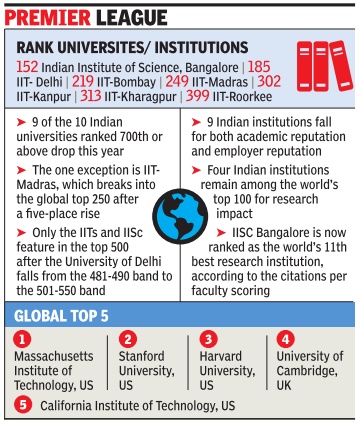
IITs lose ground in global ranking
The Indian Institutes of Technology (IITs) lost ground in the QS World University Rankings 2016-17 issued. The rankings confirmed Massachusetts Institute of Technology (MIT) in US as the world's best for the fifth consecutive year.
Indian Institute of Science+ (IISc), Bengaluru, remained India's highest-ranked institution, but dropped out of the top 150. The only good news is that IIT Madras+ has broken into the top 250, climbing up five places.
IISc's drop is symptomatic of the near-uniform drops faced by India's tertiary institutions this year, the report said. In fact, the positions of nine out of the 10 Indian universities ranked 700 or above in 2015 have dropped this year. The rankings fell for both academic and employer reputation. There are just four Indian institutions among the world's top 100 in research impact, one fewer than last year's, as IIT Madras dropped eight ranks to 101st. IISc remains India's best research institution, ranked 11th.
Ben Sowter, head of research at QS Intelligence Unit, attributes the falls to several factors. One is India's relatively low number of PhD qualified researchers. Also, India hires and attracts fewer PhD qualified researchers from abroad. He notes that no Indian institution ranked above 700 for QS's international faculty ratio metric.
QS intelligence unit noted that considerable investment -- human and capital -- is needed if Indian institutions are to remain competitive and upwardly mobile. "This year's rankings imply that levels of investment are determining who progresses and who regresses. Institutions in countries that provide high levels of targeted funding... are rising. On the other hand, Western European nations making or proposing cuts to public research spending are losing ground to their US and Asian counterparts," Sowter said.
"The performance of Indian institutions in our recent regional Rankings suggest that India is gaining some ground on its regional competitors," he added.
Elsewhere, Stanford University has displaced the University of Cambridge in the top three. This means US institutions hold all top-three places for the first time since the inaugural rankings of 2004.
2017
IISc: 10th best small university
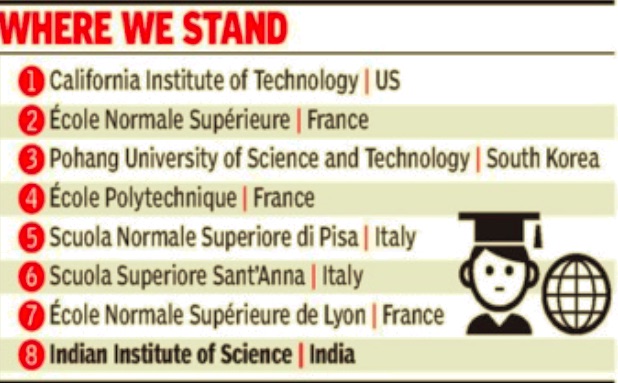
HIGHLIGHTS
Times Higher Education (THE) revealed that India is home to one of the world’s best small universities
IISc has been ranked eighth at the ‘THE’s Best Small Universities in the World 2017’
IISc, a public university for scientific research and higher education, was established in 1909
NEW DELHI: For the first time, an Indian educational institute has broken into the top 10 of a global university rankings. On Tuesday, the Times Higher Education (THE) revealed that India is home to one of the world's best small universities, as it made public the 2017 edition of the rankings. Indian Institute of Science, Bangalore, has been ranked eighth at the 'THE's Best Small Universities in the World 2017'. However, India's overall show in the ranking took a hit this year, as there were two institutions in the top 20 last year, though none were in top 10. Small universities are those with fewer than 5,000 students.
IISc, a public university for scientific research and higher education, was established in 1909 with active support from Jamsetji Tata and Sir Krishnaraja Wodeyar IV, the Maharaja of Mysore. In 2015-16 it became the first Indian institute to be ranked among the top 100 in THE World University Rankings for engineering and technology at 99th position.
IISc now joins the elite list that includes California Institute of Technology (Caltech) from the US, Ecole Normale Superieure from France and Pohang University of Science and Technology, South Korea. Caltech continues to retain its leadership position, and France and Italy each take three places among the top 10.
Despite the new high, India has two misses. Indian Institute of Technology, Guwahati, and Savitribai Phule Pune University which were ranked 14 and 18 respectively in the 2016 edition could not retain their spots in the top 20 this time.
Seeta Bhardwa, student editor at THE said, "The Best Small Universities in the World for 2017 highlights that small universities provide high student satisfaction and good working relationships between students and their professors. Many students are drawn to smaller class sizes, higher teacher to student ratios and the communitylike feel that a small university can provide.”
Indian Institutes of Technology
Alumni founders of unicorn startups
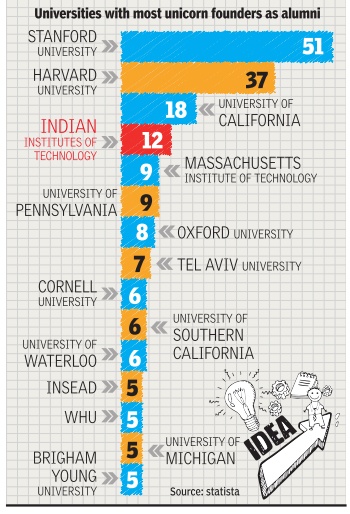
See graphic
QS Asia University Rankings 2017: IITs
IIT-B ranking rises to 34 from 35 on QS Asia charts, Oct 18 2017: The Times of India
For the performance of Indian and other South Asian universities on the QS Asia University Rankings 2018, see South Asian universities: global ranking
In 2017, Indian Institute of Technology-Bombay (IIT-B) has risen by a point -to 34 from 35 last year -on the Asian charts of the Quacquarelli Symonds (QS) University Rankings. On the other hand, though, the city's other public institution, the University of Mumbai, has slid to the 801-1,000 range from the 701-750 bracket.
Globally , California Institute of Technology has pipped University of Cambridge to occupy the fourth position in the QS rankings.The other Ivy Leagues -MIT, Stanford, Harvard -maintain their top places.
Locally , besides IIT-B, IIT Delhi and IIT Madras figure on the list of Asia's Top 50 universities. No Indian university, though, has managed to occupy a position in the Top 10. Indian Institute of Science (IISc), which was placed 33 last year, has fallen to 51 this time. IIT-Delhi is at 41 from 36 last year while IITMadras stands at 48 from 43 last year.
Speaking on the performance of the institute, director Devang Khakhar said, “I am glad that IIT-Bombay continues to rise in the rankings. This is a reflection of the excellent work being done by the faculty and students of the institute.“ The institute was among the top 8% performers in the QS Asia University Rankings. Considering that there are approximately 11,900 universities globally, this brings IIT-B among the top 1% universities in Asia.
This time around, Savitribai Phule Pune University is stable at 207 and Mumbai University has dropped from 145 to 181 in the Asian rankings. In the same region, Nanyang Technological University (NTU) was ranked number one, ahead of NUS and Hong Kong Uni versity of Science and Tech nology (HKUST).
Overall, IIT-B has im proved on its 2016-17 per formance by one place.
It is ranked number one in India, with an overall score of 75.7 out of 100. The institute has a score of 88.1in academic reputation, 97.5 in employer reputation, 44.5 in faculty student ration, 96.3 in staff with PhD, 89.6 in papers per faculty , 9.7 in international faculty , 6.3 in international students, 10.9 in inbound exchange students, 9.1 in outbound exchange students, and 41.4 in citations per paper. Among these 10 parameters, employer reputation of IIT-B was the strongest at 21globally .
2018
‘2018': BRICS universities ranking
Manash Gohain, November 23, 2017: The Times of India
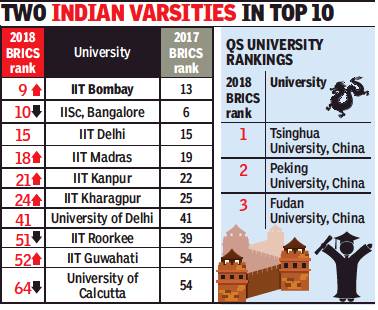
From: Manash Gohain, November 23, 2017: The Times of India
IIT-D That Ranks 15th In List Comes Third In Country
Quacquarelli Symonds (QS) ranking of Brics universities in 2018 brought a mixed bag of good and bad news for India. IITBombay, for the first time, broke into the top 10 list, bagging the 9th position (overall) and was also the best-ranked among Indian universities. It improved its rank by four positions.
Sadly, India lost its top position (6th place), secured in 2017 by Indian Institute of Science (IISc), Bengaluru, in the ranking for 2018. With its 10th rank, IISc, however, continues to be among the top institutions in Brics nations (Brazil, Russia, India, China and South Africa). Like in 2016, this year too four Indian universities, including IIT-Delhi (15th rank) and IIT-Madras (18th rank), were featured in the Top 20.
In the overall rankings, the top three remained unchanged from the 2016 list —Tsinghua University, Peking University and Fudan University — all from China, securing the first three ranks respectively.
In total, 65 Indian universities are ranked among the published top 300. This is more than Brazil’s 61 and South Africa’s 12, but fewer than Russia’s 68 and China’s
94. Seven Indian universities have made it to the top 50 list. The highest ranked private Indian university is BITS Pilani at 109, followed by Thapar University at 137 and Symbiosis International University at 144.
The top 10 public and private Indian universities in the Brics ranking were felicitated in Delhi by V S Chauhan, chairman, University Grants Commission on Wednesday. Speaking on the role of the rankings, Chauhan said the Centre launched the National Institutional Ranking Framework which was started in 2016, to make Indian institutions more competitive. On the relevance of the rankings, Chauhan said, “The role of the rankings, in helping students getting to know about the institutions they choose, can’t be negated. But sometimes they are overplayed.”
“Indian education system has expanded and we are trying to change a lot of regulations which were framed long ago. In this, there is space for providing rankings,” he added.
While stating that India is at a very early stage when it comes to its universities coming of age, Chauhan said, “We will celebrate that day when of 350 universities in the Brics rankings, 150 will be Indian institutions.”
In total, 65 Indian universities are ranked among the published top 300. This is more than Brazil’s 61 and South Africa’s 12, but fewer than Russia’s 68 and China’s 94. The highest ranked private Indian university is BITS Pilani at 109
Times Higher Education’s ‘Asia University Rankings 2018’
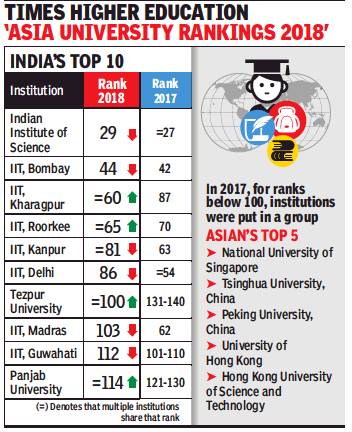
From: Manash Gohain, More Indian univs enter elite list, but rankings slide, February 7, 2018: The Times of India
India has increased its representation in the Times Higher Education’s ‘Asia University Rankings 2018’ claiming 42 places, up from 33 in 2017, with 12 new entrants.
However, several of its institutions, including many of its leading universities, have slid in the rankings of 350 top universities in Asia. At 29, the Indian Institute of Science, Bangalore remained India’s top ranked institution, but it too dropped two places from last year. There are seven universities from India that are ranked among the top 100.
National University of Singapore is the top ranked university in Asia, followed by Tsinghua University and Peking University from China.
While the number of Indian institutions in the rankings has increased, the rise is partly due to an expansion of the table to include 350 universities this year, up from around 300 in 2017. Two of the newcomers to make the top 200 of the list —Indian School of Mines at 141st and Banaras Hindu University at joint 194th.
However, India’s top two last year – IISc and IIT, Bombay have each dropped two places to 29th and 44th respectively, largely due to fall in their citation impact scores. IIT, Madras saw the biggest decline in the top 200, dropping 41 places to 103rd, also mainly due to a decline in its citations, while IIT Delhi’s ranking too dropped by 32 positions.
2019
‘2019’: Times Higher Education Rankings

From: Manash Gohain, IIT-B slips in world univ list, overtaken by Indore, September 27, 2018: The Times of India
IIT-Bombay, which was chosen as an Institute of Eminence (IoE) by the Centre, has slipped from the 351-400 band to 401-500 in the Times Higher Education (THE) World University Rankings 2019 released on Wednesday. The Powai institute has been overtaken by nine-yearold IIT-Indore, which has made an impressive debut as India’s second highest-ranked university —and a global top 400 institution —with its scores buoyed by research volume and research impact.
The country is led again by the Indian Institute of Science, Bangalore, which retains its position in the 251-300 band. No Indian institute made it to the global top
200. But India’s presence increased to 49 places this year, up from 42–the fifth best-represented nation in the world. However, most of the institutions either stagnated or declined in the 2019 table.
Deputy director (Academics) at IIT-Bombay, A K Suresh, said they are not chasing global ranks, but intend to do their best. “We do well in some ranking systems and in some others, we may not do well in certain parameters. We just work towards achieving excellence and rankings will happen in the process,” he said.
Savitribai Phule Pune University has emerged as the top state-run university in the country, being ranked in the 501–600 band, up from the 601–800 band last year.
Globally, Oxford University claimed first position for the third consecutive year, also topping the list for its the research pillar (volume, income and reputation). Cambridge retained the second spot, while Stanford in the US holds steady in third.
In a statement issued to THE, Pradeep Mathur, director of IIT Indore, said: “Our efforts in making research the focus of the institute is now reflected in the form of citation and other impact metrics of research. We continue to make research the focus of all our programmes which is why you see even our undergraduate students are active participants of research projects and collaborations within India and internationally too.”
Among the previously ranked Indian institutions, Amrita University saw an impressive rise in the 2019 table—from the 801-1,000 band to 601-800 this year-—with particular improvement in its citation impact (research influence) score.
Times Emerging Economies
India moves up Times global varsity list with 49 institutions, January 17, 2019: The Times of India
India has improved its showing in the prestigious university rankings of Times Higher Education Emerging Economies with 49 institutions making it to the list, including 25 in the top 200.
China remains the most represented nation in the annual 2019 listing, claiming four of the table’s top five positions with Tsinghua University topping the chart, according to the London-based Times Higher Education (THE), a global organisation that produces data, analysis and expertise on higher education.
Leading India again is the Indian Institute of Science (14th), followed by the Indian Institute of Technology Bombay (27th). However, both of them slipped back a place this year, due to increased competition.
The 2019 ranking comprises nearly 450 universities — expanded from 378 last year — from 43 countries, across four continents. This year’s table presents a mixed picture for India, with several new entrants and high risers, alongside institutions that dropped back.
India has increased its representation in the Times Higher Education Emerging Economies University Rankings with 49 universities in the list as compared to 42 in 2018, the organisation said. India has 25 universities in the top 200, a rise from 17 last year, it said.
IIT Roorkee, however, scales 21 places — and into the top 40 — at 35th, thanks to improvements in its research (volume, income and reputation) and industry income (knowledge transfer). Indian Institute of Technology Indore (61st) and JSS Academy of Higher Education and Research (joint 64th) are the highest new entrants for India this year.
Savitribai Phule Pune University climbs 87 positions to joint 93rd, alongside the National Autonomous University of Mexico. Banaras Hindu University and Amrita University both scaled this year into the top 150, while the Indian Institute of Science Education and Research, Pune and IIT Hyderabad featured for the first time in this group.
Ellie Bothwell, global rankings editor for THE, said: “Indian institutions have immense potential for success. In this year’s table, India's institutions perform well in teaching. However, they are significantly behind the global average in terms of international outlook”.
2020
Indian universities, among the world’s Top 400 in 2019 and 2020
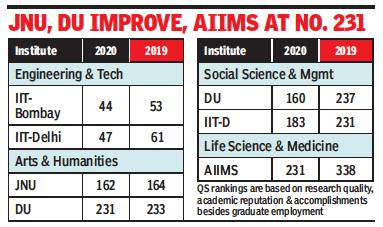
From: Hemali Chhapia & Manash Pratim Gohain, Bombay, Delhi IITs break into top 50 in world univ ranking, March 5, 2020: The Times of India
Mumbai/New Delhi:
For the first time, Indian technical institutions have found place among the top 50 in QS World University Ranking by subject, with IIT-Bombay and IIT-Delhi occupying the 44th and 47th rank, respectively, this year in engineering & technology.
India also improved its presence in the top 100 list with five institutions featuring this year as against three in last year’s rankings. In the arts and humanities category, Jawaharlal Nehru University improved its ranking from 166 to 164 among the top 500 universities with the University of Delhi too featuring among the top 250 in this category.
Massachusetts Institute of Technology is at pole position for the eighth year in a row. In the second and third positions are Stanford and Cambridge, respectively.
Delhi has the most number of institutions from India among the top 200 with IIT-Delhi and DU again featuring in the social science & management category.
AIIMS ranks 231 in medicine category
AIIMS has been ranked 231 in life science & medicine category, improving its rank from 338 in 2019. IIM-Ahmedabad and IIM-Bangalore rank in the 51-100 band for business & management studies. Globally, Harvard, INSEAD and London Business School occupy the top three places. With design technology picking up pace, the National Institute of Design ranked in the 101-150 band. The Royal College of Art, UK, topped the charts in this category.
In terms of overall ranks, IIT-B occupies the 152nd position, 10 spots higher as compared to last year. IIT-Delhi comes next at the 182nd (172 in 2019) place, followed closely by the Indian Institute of Science at 184th. Among traditional universities, DU is ranked 474, followed by Hyderabad and Jadavpur. The Universities of Mumbai and Pune remain in the 801-1001 band of rankings.
Union HRD minister Ramesh Pokhriyal said: “It is a significant achievement of our premier engineering institutions, which has made India proud.” IIT-D director V Ramgopal Rao said: “We are very happy to see a significant improvement in our rankings. This is a result of the various measures we have taken in the institute on boosting the research ecosystem, bettering teacher-student ratio and strengthening our connect with external stakeholders in the last three years. The number of international students has gone up to 130, most of them pursuing their masters and PhD.”
Employability/ THE
Manash Gohain, November 19, 2020: The Times of India

From: Manash Gohain, November 19, 2020: The Times of India
India features among top 15 countries with universities producing the most employable graduates. In the Employability Rankings 2020, India has improved its ranking from 23 in 2010 to 15 in 2020, even as UK and US varsities showed declined.
The study by Times Higher Education (THE) and French consultancy, Emerging, for most employable locations for higher education, shows how top institutions in the US and the UK have masked the general decline of American and British universities in terms of employability. Countries, which have been taking employability more seriously over the past 10 years, are becoming more attractive than the US and the UK for students.
IIT-D climbs to 27th spot on list of top 250 global univs
India (15th) has been one of the high performers for employability over the last decade along with Germany (ranked 3rd), China (5th) and South Korea (9th). India also increased its representation in the top 250 universities worldwide — from four in 2019 to six in 2020. A notable performer is IIT-Delhi, which ranked 149th in 2014 and moved up to 27th in 2020.
As the Covid-19 situation has made finding work difficult for graduates, the study says students and parents are even more driven by the ability to get job rather than the reputation of a university. Although California Institute of Technology (1st), MIT (2nd) and Harvard (3rd) continue to dominate, there has been a general decline in higher education in the US. Its country score fell by 51% in the last 10 years — from 4,227 in 2010 to 2,067 in 2020.
The UK, too, where a small group of elite institutions are covering the general decline of its higher education system, fell from 2nd position in 2010 to 4th in 2020 in terms of best performing countries for employability. Its country score dropped by 46% in 10 years (1299 in 2010 to 697 in 2020). China’s country score saw an increase of 132% over the past 10 years (208 in 2010 to 481 in 2020).
See also
Education: India (covers issues common to all categories of Education) <> Indian universities: national ranking <> Engineering education: India <> Higher Education: India <> Medical education and research: India <> Primary Education: India <> School education: India (covers issues common to Primary and Secondary Education) <> Secondary Education: India <>
South Asian universities: global ranking
Indian universities: global ranking
Indian universities: national ranking
Indian universities: national ranking, 2017
Indian universities: national ranking, 2018
Indian universities: national ranking, 2019
Indian universities: issues and trends
Indian students in international universities
...and many more.
